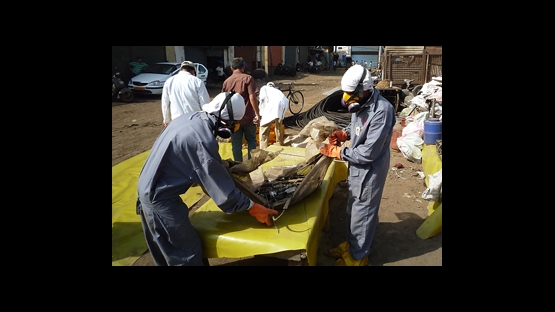In 2010, the Chemistry Department at the University of Delhi sold a machine containing cobalt-60 sealed radioactive sources (SRS) to a scrap metal dealer as part of a campus-wide project to get rid of outdated laboratory machinery. No one realized that it contained SRSs.
The machine was dismantled by the dealer and several scrap yard workers who were unaware of the hazards within this device. One of the SRS was cut into pieces for testing and one of the pieces was given to a second dealer who put it in his wallet.
A few weeks later, the first dealer developed skin lesions and diarrhoea, and was hospitalized with radiation sickness, prompting an investigation that resulted in authorities confirming the presence of sealed radioactive sources at the scrap yard. The second dealer developed radiation burns on his buttocks and later collapsed. A total of eight individuals were hospitalized with radiation injuries. One of the individuals died from multiple organ failures due to exposure to very high levels of radiation.
Authorities recovered the intact sources and fragments at the original shop and a nearby shop as well as the fragment from the dealer's wallet. Authorities also removed some contaminated soil.
Over the years, improper management of SRS has resulted in several serious radiological accidents in various countries. Exposure to unshielded SRS can potentially be fatal, while contamination resulting from the dispersion of the radioactive material can lead to serious consequences. In most countries, the use of SRS is regulated to ensure safety and security. Examples of regulatory requirements include proper training and education in radiation safety and physical protection.
SRS are usually used for a number of years after which these sources are categorized as "spent" or "disused". A dangerous amount of radioactive material may remain in some disused sealed radioactive sources (DSRS), which in turn, may present a radiological hazard. DSRS should, therefore, be managed in a safe and secure manner to minimize the risks associated with radiation exposure and potential misuse of the source.
The Code of Conduct on the Safety and Security of Radioactive Sources (the Code) was established to achieve and maintain a high level of safety and security of radioactive sources across the globe. The idea for the development of the Code was first discussed at an International Conference in Dijon, France, in 1998 that addressed measures necessary for the safe and secure use of radioactive sources. The Conference noted that many countries have weak radiation protection programmes and suggested that the establishment of an "international undertaking" could ensure continuity in regulatory control. The Code was drafted over several meetings. Following the terrorist attacks on 11 September 2001, the provisions in the text addressing the security of radioactive sources were enhanced. In September 2003, the Code was approved and the IAEA General Conference invited States to make a political commitment to work towards the principles therein and currently 119 States have done so.
In addition to the Code, the IAEA Safety Standards provide guidance to Member States on the safe management of radioactive sources throughout their life from their production to disposal. The IAEA has also developed binding international requirements through the Joint Convention on the Safety of Spent Fuel Management and the Safety of Radioactive Waste Management, which addresses DSRS. Further, the IAEA Nuclear Security Series was established to provide guidance to States on how to implement security measures to complement the safety standards.


